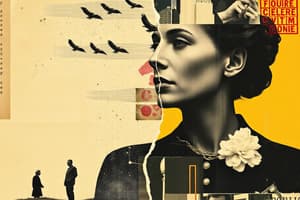Podcast
Questions and Answers
According to Latane and Darley's cognitive model, what was the result of the study involving students communicating through microphones in separate cubicles?
According to Latane and Darley's cognitive model, what was the result of the study involving students communicating through microphones in separate cubicles?
- The more bystanders an individual thought were present, the less likely they were to help (correct)
- The students were equally likely to help regardless of the number of bystanders
- The presence of bystanders did not affect the likelihood of helping
- The more bystanders an individual thought were present, the more likely they were to help
What is the hypothesis that causes the bystander effect?
What is the hypothesis that causes the bystander effect?
- Empathy
- Diffusion of responsibility (correct)
- Altruistic views
- Pluralistic ignorance
In what type of emergency situation are bystanders less likely to help, according to the text?
In what type of emergency situation are bystanders less likely to help, according to the text?
- An emergency situation that is a usual event
- An emergency situation that involves danger to a person or property (correct)
- An emergency situation that is foreseen and planned
- An emergency situation that requires instant action
What did the study by Latane and Darley involving students communicating through microphones aim to investigate?
What did the study by Latane and Darley involving students communicating through microphones aim to investigate?
What is the key concept underlying the hypothesis of diffusion of responsibility?
What is the key concept underlying the hypothesis of diffusion of responsibility?
According to the text, what type of emergency situation requires instant action and is less likely to receive bystander help?
According to the text, what type of emergency situation requires instant action and is less likely to receive bystander help?
What did the study by Darley and Latane in 1968 reveal about the relationship between the number of bystanders and the likelihood of helping?
What did the study by Darley and Latane in 1968 reveal about the relationship between the number of bystanders and the likelihood of helping?
In a Sequential Protocol, what do players do?
In a Sequential Protocol, what do players do?
What is the impact of harvesting sequentially in a Common Resource Pool?
What is the impact of harvesting sequentially in a Common Resource Pool?
What effect is observed in a Sequential Common Resources Pool dilemma?
What effect is observed in a Sequential Common Resources Pool dilemma?
What type of Protocol involves real-time interactions?
What type of Protocol involves real-time interactions?
What is the focus of Discussion on dilemma in the context of cooperation?
What is the focus of Discussion on dilemma in the context of cooperation?
What is the impact of individuals harvesting simultaneously in a Common Resource Pool?
What is the impact of individuals harvesting simultaneously in a Common Resource Pool?
What is the relationship between position and the size of request in a Sequential Common Resources Pool dilemma?
What is the relationship between position and the size of request in a Sequential Common Resources Pool dilemma?
What is the impact of individuals harvesting simultaneously in a Common Resource Pool?
What is the impact of individuals harvesting simultaneously in a Common Resource Pool?
What is the focus of Discussion on dilemma in the context of cooperation?
What is the focus of Discussion on dilemma in the context of cooperation?
In the Prisoner’s Dilemma, what type of game is it described as?
In the Prisoner’s Dilemma, what type of game is it described as?
What strategy involves starting with cooperation and mimicking the opponent's action in an iterated prisoner's dilemma?
What strategy involves starting with cooperation and mimicking the opponent's action in an iterated prisoner's dilemma?
What do social dilemmas, such as common resource pool dilemmas, model?
What do social dilemmas, such as common resource pool dilemmas, model?
What type of dilemmas involve cooperation and free-rider problems?
What type of dilemmas involve cooperation and free-rider problems?
What can help solve social dilemmas according to the text?
What can help solve social dilemmas according to the text?
What is important in simultaneous protocol games, where all players make decisions at the same time with identical information?
What is important in simultaneous protocol games, where all players make decisions at the same time with identical information?
What does the game theory concept emphasize in reducing conflict and promoting mutual benefit?
What does the game theory concept emphasize in reducing conflict and promoting mutual benefit?
According to the Bystander-Calculus Model, what is involved in the evaluation of consequences of helping in an emergency?
According to the Bystander-Calculus Model, what is involved in the evaluation of consequences of helping in an emergency?
In the 'Where there’s smoke there’s fire' study by Darley and Latane, what did the study demonstrate?
In the 'Where there’s smoke there’s fire' study by Darley and Latane, what did the study demonstrate?
Which factor plays a role in helping behavior according to the text?
Which factor plays a role in helping behavior according to the text?
What do norms such as social responsibility and reciprocity influence according to the text?
What do norms such as social responsibility and reciprocity influence according to the text?
What is the main cost of helping according to the Bystander-Calculus Model?
What is the main cost of helping according to the Bystander-Calculus Model?
What role does empathy play in helping behavior according to the text?
What role does empathy play in helping behavior according to the text?
What do game theory scenarios such as the 'Battle of the Sexes' and 'Game of Chicken' illustrate according to the text?
What do game theory scenarios such as the 'Battle of the Sexes' and 'Game of Chicken' illustrate according to the text?
Flashcards are hidden until you start studying
Study Notes
Social Comparison Theory and Bystander-Calculus Model
- Social Comparison Theory involves comparing behavior and opinions with others to establish socially approved ways of thinking and behaving, such as in purchasing decisions.
- Two variations of the social comparison perspective are the bandwagon effect, where individuals adopt a popular attitude to gain status, and pluralistic ignorance, where people publicly behave differently from their actual beliefs due to ignorance of others' thoughts.
- "Where there’s smoke there’s fire" study by Darley and Latane in 1968 demonstrated the bystander effect, showing that individuals were less likely to report an emergency when in the presence of others, with the response slowing as the number of people present increased.
- The Bystander-Calculus Model explains that individuals calculate the perceived costs and benefits of providing help in an emergency before responding, involving three stages: physiological arousal, labeling this arousal as an emotion, and evaluating the consequences of helping.
- Physiological arousal plays a role in helping behavior, as greater arousal increases the likelihood of helping, and situational cues trigger empathic concern, especially when bystanders believe they are similar to the victim.
- The evaluation of consequences of helping involves choosing an action that reduces personal distress at the lowest cost, with time and effort being the main costs of helping.
- The model also considers empathy costs and personal costs of not helping, where empathy concern and the characteristics of the person in distress affect the costs of not helping, influencing the bystander's decision to help.
- Norms such as social responsibility and reciprocity can influence helping behavior, as individuals may feel a responsibility to help those dependent on them, but conflicting norms may discourage interfering in others' lives.
- Empathy and altruism play a role in helping behavior, with individuals intervening in emergencies to seek relief from unpleasant arousal and being motivated by feelings of warmth and compassion for those in need.
- Feedback manipulation, egoism, and mixed-motive interactions can influence helping behavior, where people may help others only if they receive feedback indicating improvement and may engage in mixed-motive interactions in various situations.
- The Ultimatum game, a real-life application of social norms and social exchange theory, involves decision-making and allocation of resources, reflecting how people weigh costs and rewards before deciding what to do.
- The "Battle of the Sexes" and "Game of Chicken" are examples of game theory scenarios that illustrate decision-making and strategic interactions in different contexts, emphasizing the complexities of human decision-making and behavior.
Studying That Suits You
Use AI to generate personalized quizzes and flashcards to suit your learning preferences.




